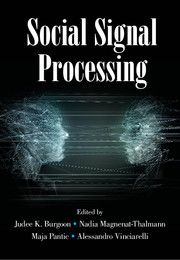Book contents
- Frontmatter
- Contents
- Contributors
- 1 Introduction: Social Signal Processing
- Part I Conceptual Models of Social Signals
- 2 Biological and Social Signaling Systems
- 3 Universal Dimensions of Social Signals: Warmth and Competence
- 4 The Vertical Dimension of Social Signaling
- 5 Measuring Responses to Nonverbal Social Signals: Research on Affect Receiving Ability
- 6 Computational Analysis of Vocal Expression of Affect: Trends and Challenges
- 7 Self-presentation: Signaling Personal and Social Characteristics
- 8 Interaction Coordination and Adaptation
- 9 Social Signals and Persuasion
- 10 Social Presence in CMC and VR
- Part II Machine Analysis of Social Signals
- Part III Machine Synthesis of Social Signals
- Part IV Applications of Social Signal Processing
- References
10 - Social Presence in CMC and VR
from Part I - Conceptual Models of Social Signals
Published online by Cambridge University Press: 13 July 2017
- Frontmatter
- Contents
- Contributors
- 1 Introduction: Social Signal Processing
- Part I Conceptual Models of Social Signals
- 2 Biological and Social Signaling Systems
- 3 Universal Dimensions of Social Signals: Warmth and Competence
- 4 The Vertical Dimension of Social Signaling
- 5 Measuring Responses to Nonverbal Social Signals: Research on Affect Receiving Ability
- 6 Computational Analysis of Vocal Expression of Affect: Trends and Challenges
- 7 Self-presentation: Signaling Personal and Social Characteristics
- 8 Interaction Coordination and Adaptation
- 9 Social Signals and Persuasion
- 10 Social Presence in CMC and VR
- Part II Machine Analysis of Social Signals
- Part III Machine Synthesis of Social Signals
- Part IV Applications of Social Signal Processing
- References
Summary
Introduction
The first message by telegraph was sent by Samuel Morris and read, “What hath God wrought?” The first words communicated via telephone were, “Mr. Watson – Come here – I want to see you.” We can see that over a relatively short period of time what was first considered a feat to reckon with the powers of the universe became somewhat more mundane. When it comes to telecommunications and, later, computer-mediated communication (CMC) and virtual reality (VR), what can be achieved in terms of social presence is all a matter of one's perspective and goals.
The original goal of CMC was to increase social presence by emulating face-to face communication, thereby increasing the feeling that you were actually with another person. Short, Williams, and Christie (1976) first formally introduced the concept of social presence as a distinguishing attribute of telecommunication events. The commercial world abbreviated this concept quite well when telephone companies beckoned us to “reach out and touch someone.” Increasing social presence meant transmitting social signals and creating richer contexts for communication with the ultimate goal of being indiscernibly like face-to-face communication. Face-to-face (FtF), one-on-one, real-time interaction with all the verbal and nonverbal modes of communication occurring without lag or filtration was to be the pinnacle of communication technologies. To this end, we have created very rich social signal environments that strive for this canon.
The current state of technology, however, allows us to go beyond this “mundane” goal of strict veridicality and back to a more awe-inspiring realm of possibility. Given the nature of CMC, namely the ease with which one can alter variables in code, and the flexibility of mental models, new goals can be attained. Realness is now the mundane goal. Augmentation and enhancement are the new frontier.
Early CMC
In the early days of CMC, communication was limited to asynchronous, text-based formats. Listservs, e-mail, and other discussion forums were places where one could post and read, but responses were not immediate. The process of having a dialogue was stilted and slow. There were no visual or audio cues and misinterpretation or deceit in messages undermined clear communication.
- Type
- Chapter
- Information
- Social Signal Processing , pp. 110 - 120Publisher: Cambridge University PressPrint publication year: 2017
References
- 2
- Cited by



